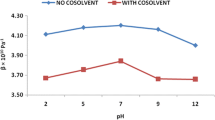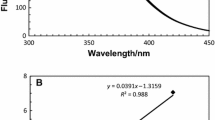Abstract
Thermal stability of bovine α-lactalbumin in the presence of three different calcium concentrations in aqueous solutions of several concentrations of erythritol, xylitol, sorbitol, and inositol at pH 6.5 was evaluated by UV absorbance, fluorescence spectroscopy, and circular dichroism spectroscopy. At the selected conditions, the thermal denaturation process is reversible and is well described by a two-state model. Results show a higher stability for the holo form of the protein in the presence of calcium, followed by the holo- and the apo-lactalbumin, respectively. The stabilizing effect of the polyols increases with polyol concentration and it is higher for the apo-lactalbumin than holo-lactalbumin and is very small for the protein in the presence of a calcium excess.






Similar content being viewed by others
References
Permyakov EA, Berliner LJ. α-Lactalbumin: structure and function. FEBS Lett. 2000;473:269–74.
Chrysina ED, Brew K, Acharya KR. Crystal structures of apo- and holo-bovine α-lactalbumin at 2.2-Å resolution reveal an effect of calcium on inter-lobe interactions. J Biol Chem. 2000;257:37021–9.
Kronman MJ, Andreotti RE. Inter- and intramolecular interactions of α-lactalbumin. I. The apparent heterogeneity at acid pH. Biochemistry. 1964;3:1145–51.
Apenten RKO. A three-state heat-denaturation of bovine α-lactalbumin. Food Chem. 1995;52:131–3.
Zhong H, Gilmanshin R, Callender R. An FTIR study of the complex melting behavior of α-lactalbumin. J Phys Chem B. 1999;103:3947–53.
Griko YV, Freire E, Privalov PL. Energetic of the α-lactalbumin states: a calorimetric and statistical thermodynamic study. Biochemistry. 1994;33:1889–99.
Apenten RKO. Thermodynamic parameters for 3-state thermal denaturation of human and bovine α-lactalbumin. Thermochim Acta. 1995;262:1–12.
Veprintsev DB, Permyakov SE, Permyakov EA, Rogov VV, Cawthern KM, Berliner LJ. Cooperative thermal transitions of bovine an human apo-α-lactalbumins: evidence for a new intermediate state. FEBS Lett. 1997;412:625–8.
Hendrix TM, Griko Y, Privalov P. Energetic of structural domains in α-lactalbumin. Protein Sci. 1996;5:923–31.
Sekhar G, Prakash V. Interaction of selected cosolvents with bovine α-lactalbumin. Int J Biol Macromol. 2008;42:348.
O’Connor TF, Debenedetti PG, Carbeck JD. Stability of proteins in the presence of carbohydrates; experiments and modeling using scaled particle theory. Biophys Chem. 2007;127:51–63.
France RM, Grossman SH. Acrylamide quenching of apo- and holo-α-lactalbumin in guanidine hydrochloride. Biochem Biophys Res Commun. 2000;269:709–12.
Banerjee T, Kishore N. Insights into the energetics and mechanism underlying the interaction of tetraethylammonium bromide with proteins. J Chem Therm. 2007 (in press).
Cawthern KM, Narayan M, Chaudhuri D, Permyakov EA, Berliner LJ. Interactions of α-lactalbumin with fatty acids and spin label analogs. J Biol Chem. 1997;272:30812–6.
Rishi V, Anjum F, Ahmad F, Pfeil W. Role of non-compatible osmolytes in the stabilization of proteins during heat stress. Biochem J. 1998;329:137–43.
Davis-Searles PR, Saunders AJ, Erie DA, Winzor DJ, Pielak GJ. Interpreting the effects of small uncharged solutes on protein folding equilibria. Annu Rev Biophys Biomol Struct. 2001;30:271.
Kaushik J, Bhat R. Thermal stability of proteins in aqueous polyol solutions: role of the surface tension of water in the stabilizing effect of polyols. J Phys Chem B. 1998;102:7058–66.
Xie G, Timasheff SN. The thermodynamic mechanism of protein stabilization by trehalose. Biophys Chem. 1997;64:25–43.
Haque I, Singh R, Moosavi-Movahedi AA, Ahmed F. Effect of polyol osmolytes on ΔGD, the Gibbs energy of stabilisation of proteins at different pH values. Biophys Chem. 2005;117:1–12.
Wetlaufer DB. Osmometry and general characterization of α-lactalbumin. CR Trav Lab Carlsberg. 1961;32:125–38.
Cooper A. Thermodynamics of protein folding and stability. In: Allen G, editor. Protein: a comprehensive treatise, vol. 2. Stamford: JAI Press Inc.; 1999. p. 217–70.
Romero CM, Albis A, Lozano JM, Sancho J. Thermodynamic study of the influence of polyols and glucose on the thermal stability of holo-bovine α-lactalbumin. J Therm Anal Calorim. 2009;98:165–71.
Albis A, Lozano JM, Romero CM. Estabilización de la holo-α-lactoalbúmina en presencia de polioles. Rev Colomb Quím. 2009;38:209–19.
Hendrix T, Griko YV, Privalov PL. A calorimetric study of the influence of calcium on the stability of bovine α-lactalbumin. Biophys Chem. 2000;84:27–34.
Xie G, Timasheff SN. Mechanism of the stabilization of ribonuclease A by sorbitol: preferential hydration is greater for the denatured than for the native protein. Protein Sci. 1997;6:211–21.
Wimmer R, Olsson M, Neves Petersen MT, Hatti-Kaul R, Petersen SB, Müller N. Towards a molecular level understanding of protein stabilization: the interaction between lysozyme and sorbitol. J Biotechnol. 1997;55:85–100.
Tiwari A, Bhat R. Stabilization of yeast hexokinase A by polyol osmolytes: Correlation with the physicochemical properties of aqueous solutions. Biophys Chem. 2006;124:90–9.
Santoro MM, Liu Y, Khan SMA, Hou L-X, Bolen DW. Increased thermal stability of proteins in the presence os naturally occurring osmolytes. Biochemistry. 1992;31:5278–83.
Parsegian VA, Rand RP, Rau DC. Osmotic stress, crowding, preferential hydration, and binding: a comparación of perspectives. PNAS. 2000;97:3987–92.
Timasheff SN. Thermodynamic binding and site occupancy in the light of the Schellman exchange concept. Biophys Chem. 2002;101–102:99–111.
Acknowledgements
This work was supported by Universidad Nacional de Colombia, COLCIENCIAS and by grant BFU2007-61476/BMC (Spain).
Author information
Authors and Affiliations
Corresponding author
Rights and permissions
About this article
Cite this article
Albis, A., Lozano, J.M., Sancho, J. et al. Influence of calcium on the thermal stabilization of bovine α-lactalbumin by selected polyols. J Therm Anal Calorim 104, 37–44 (2011). https://doi.org/10.1007/s10973-010-1156-3
Published:
Issue Date:
DOI: https://doi.org/10.1007/s10973-010-1156-3




